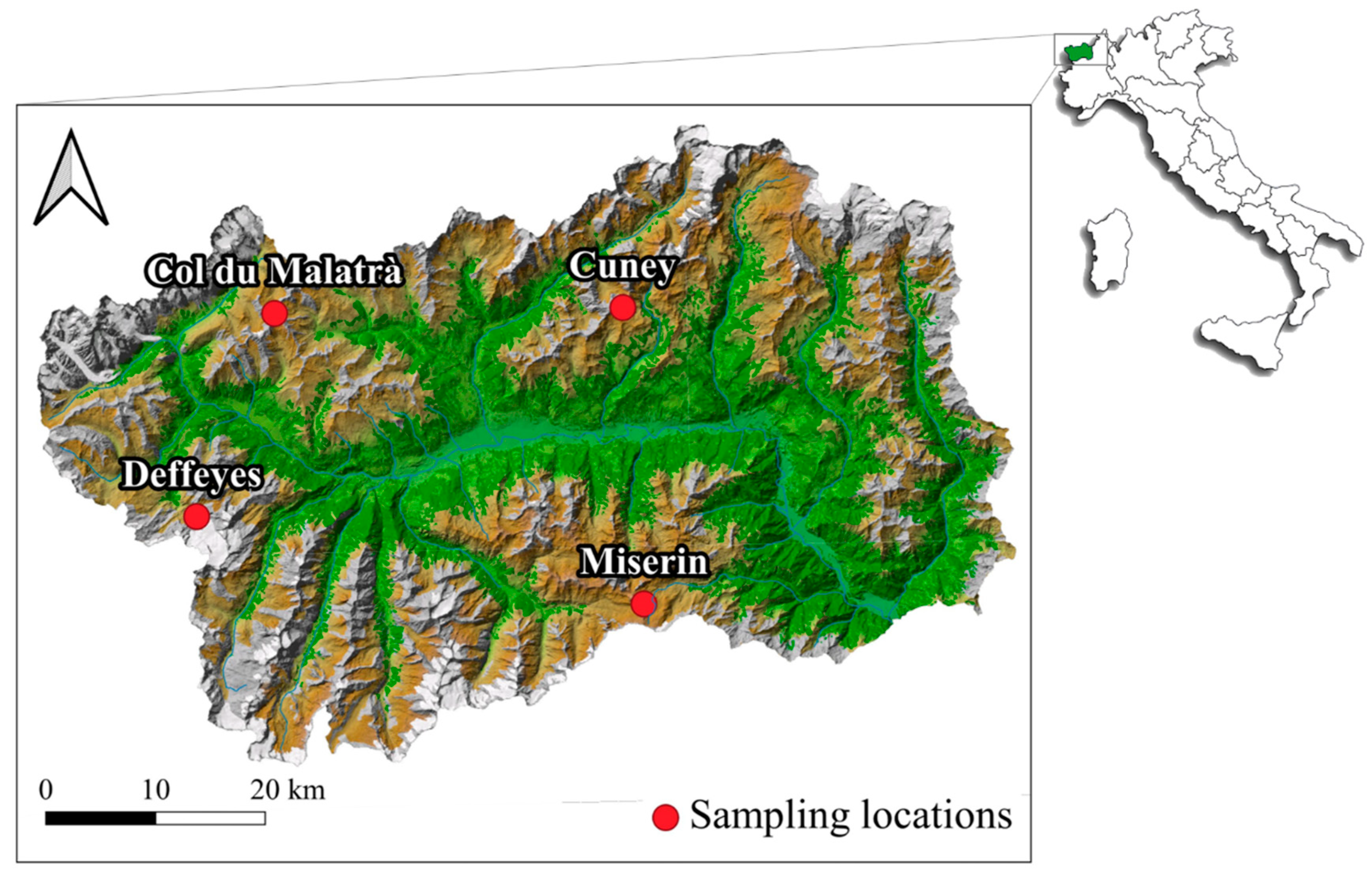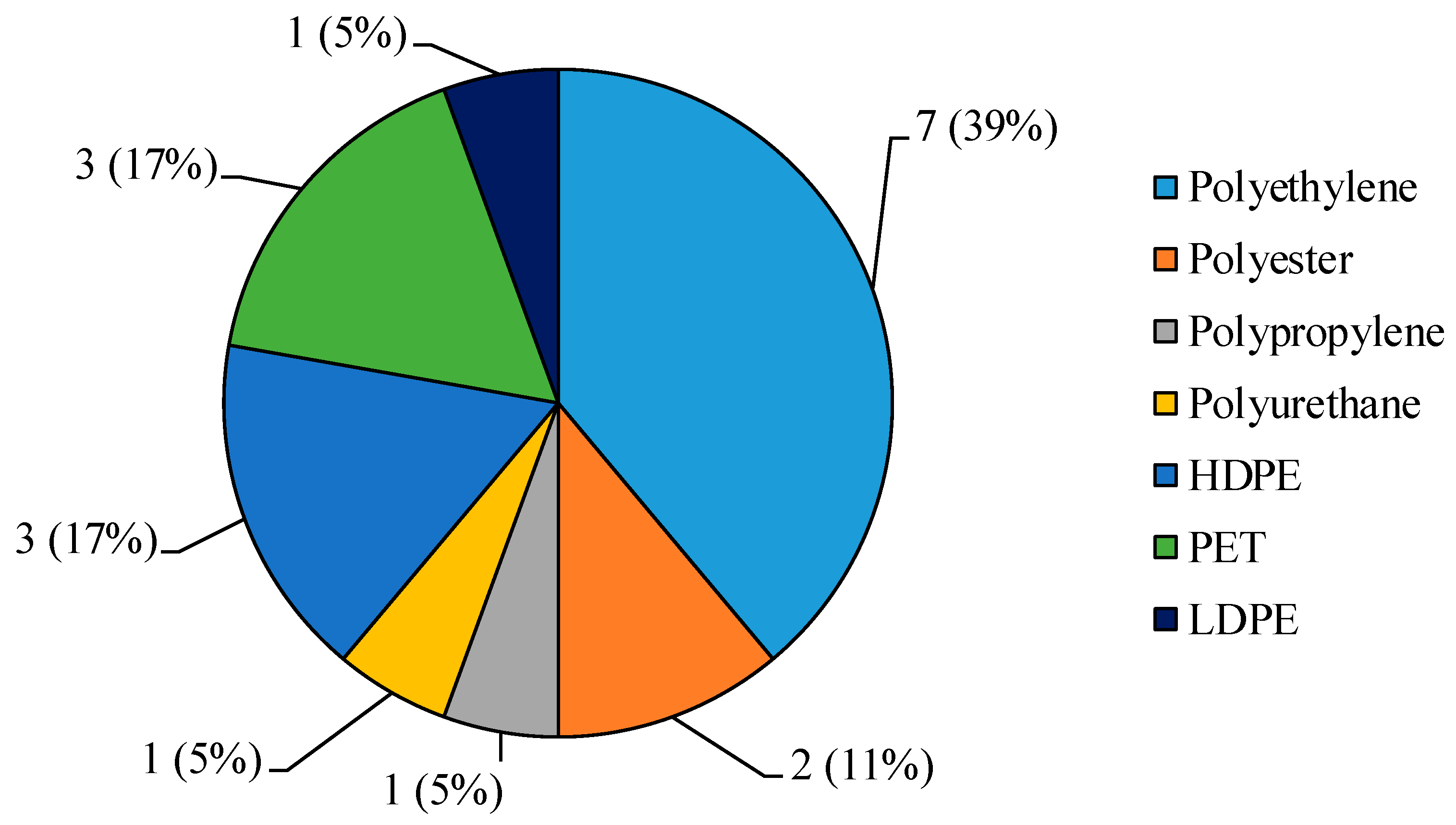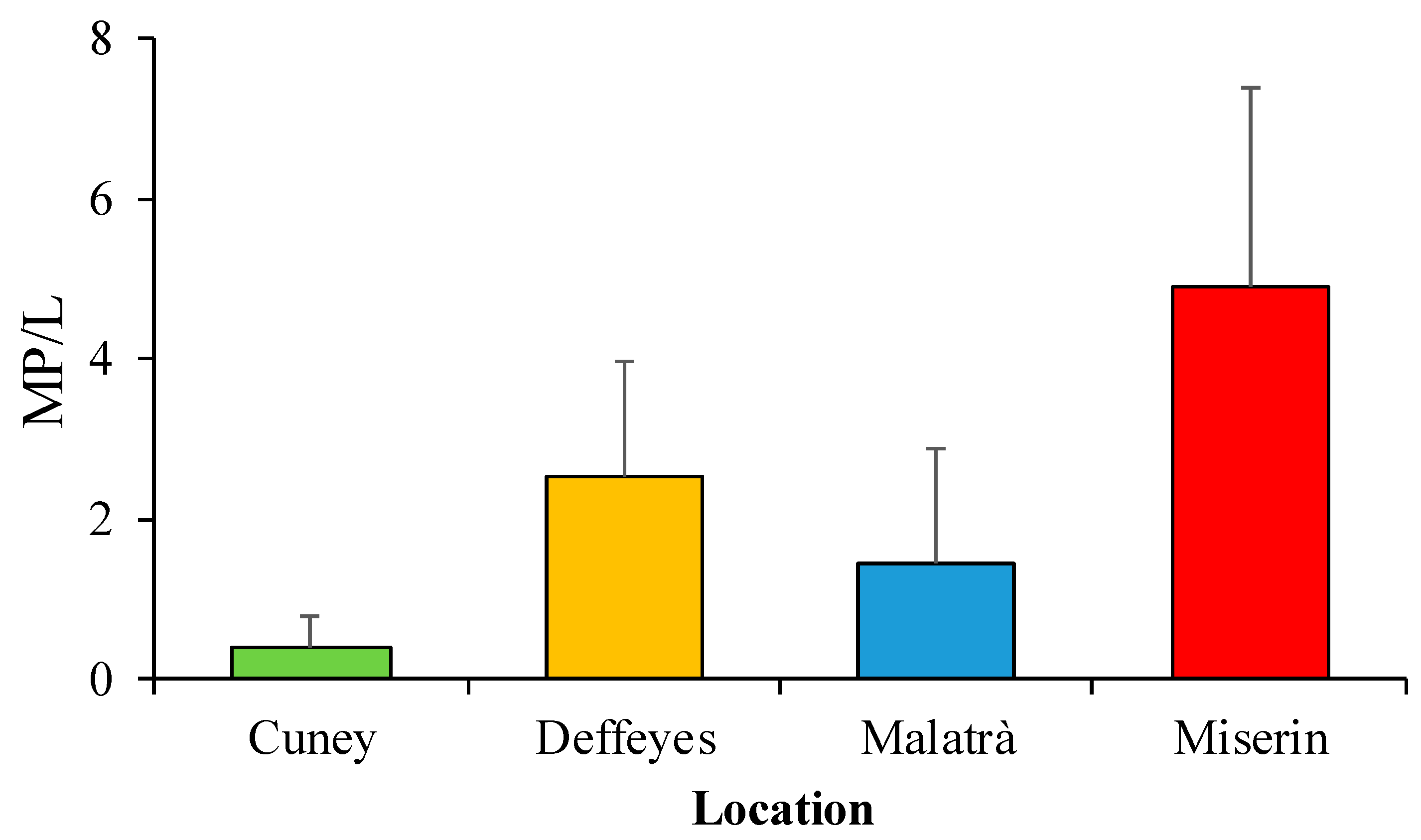Microplastic Contamination in Snow from Western Italian Alps
Abstract
1. Introduction
2. Materials and Methods
2.1. Sampling Locations
2.2. Snow Sampling
2.3. Isolation and Characterization of Microplastics
2.4. Statistical Analysis
3. Results
4. Discussion
5. Conclusions
Author Contributions
Funding
Institutional Review Board Statement
Informed Consent Statement
Data Availability Statement
Acknowledgments
Conflicts of Interest
References
- Peeken, I.; Primpke, S.; Beyer, B.; Gütermann, J.; Katlein, C.; Krumpen, T.; Bergmann, M.; Hehemann, L.; Gerdts, G. Arctic sea ice is an important temporal sink and means of transport for microplastic. Nat. Commun. 2018, 9, 1–12. [Google Scholar] [CrossRef] [PubMed]
- GESAMP. Sources, Fate and Effects of Microplastics in the Marine Environment: A Global Assessment; Reports and studies GESAMP; Kershaw, P.J., Ed.; IMO/FAO/UNESCO-IOC/UNIDO/WMO/IAEA/UN/UNEP/UNDP Joint Group of Experts on the Scientific Aspects of Marine Environmental Protection: London, UK, 2015; Volume 93, p. 96. [Google Scholar]
- Li, J.; Song, Y.; Cai, Y. Focus topics on microplastics in soil: Analytical methods, occurrence, transport, and ecological risks. Environ. Poll. 2020, 257, 113570. [Google Scholar] [CrossRef] [PubMed]
- Panebianco, A.; Nalbone, L.; Giarratana, F.; Zino, G. First discoveries of microplastics in terrestrial snails. Food Control 2019, 106, 106722. [Google Scholar] [CrossRef]
- He, D.; Luo, Y.; Lu, S.; Liu, M.; Song, Y.; Lei, L. Microplastics in soils: Analytical methods, pollution characteristics and ecological risks. Trends Anal. Chem. 2018, 109, 163–172. [Google Scholar] [CrossRef]
- Hamid, F.S.; Bhatti, M.S.; Anuar, N.; Mohan, P.; Periathamby, A. Worldwide distribution and abundance of microplastic: How dire is the situation? Waste Manag. Res. 2018, 36, 873–897. [Google Scholar] [CrossRef] [PubMed]
- Ross, P.S.; Chastain, S.; Vassilenko, E.; Etemadifar, A.; Zimmermann, S.; Quesnel, S.-A.; Eert, J.; Solomon, E.; Patankar, S.; Posacka, A.M.; et al. Pervasive distribution of polyester fibres in the Arctic Ocean is driven by Atlantic inputs. Nat. Commun. 2021, 12, 106. [Google Scholar] [CrossRef]
- Free, C.M.; Jensen, O.P.; Mason, S.A.; Eriksen, M.; Williamson, N.J.; Boldgiv, B. High-levels of microplastic pollution in a large, remote, mountain lake. Mar. Pollut. Bull. 2014, 85, 156–163. [Google Scholar] [CrossRef]
- Zhang, K.; Su, J.; Xiong, X.; Wu, X.; Wu, C.; Liu, J. Microplastic pollution of lakeshore sediments from remote lakes in Tibet plateau, China. Environ. Pollut. 2016, 219, 450–455. [Google Scholar] [CrossRef]
- Scheurer, M.; Bigalke, M. Microplastics in Swiss floodplain soils. Environ. Sci. Technol. 2018, 52, 3591–3598. [Google Scholar] [CrossRef]
- Ambrosini, R.; Azzoni, R.S.; Pittino, F.; Diolaiuti, G.; Franzetti, A.; Parolini, M. First evidence of microplastic contamination in the supraglacial debris of an alpine glacier. Environ. Pollut. 2019, 253, 297–301. [Google Scholar] [CrossRef]
- Gewert, B.; Plassmann, M.M.; Macleod, M. Pathways for degradation of plastic polymers floating in the marine environment. Environ. Sci. Process. Impacts 2015, 17, 1513–1521. [Google Scholar] [CrossRef] [PubMed]
- Evangeliou, N.; Grythe, H.; Klimont, Z.; Heyes, C.; Eckhardt, S.; Lopez-Aparicio, S.; Stohl, A. Atmospheric transport is a major pathway of microplastics to remote regions. Nat. Comm. 2020, 11, 1–11. [Google Scholar] [CrossRef] [PubMed]
- Allen, S.; Allen, D.; Phoenix, V.R.; Roux, G.; Jimenez, P.D.; Simonneau, A.; Binet, S.; Galop, D. Atmospheric transport and deposition of microplastics in a remote mountain catchment. Nat. Geosci. 2019, 12, 339–344. [Google Scholar] [CrossRef]
- SAPEA. Science Advice for Policy by European Academies. In A Scientific Perspective on Microplastics in Nature and Society; SAPEA: Berlin, Germany, 2019. [Google Scholar] [CrossRef]
- Dris, R.; Gasperi, J.; Rocher, V.; Saad, M.; Renault, N.; Tassin, B. Microplastic contamination in an urban area: A case study in Greater Paris. Environ. Chem. 2015, 12, 592–599. [Google Scholar] [CrossRef]
- Dehghani, S.; Moore, F.; Akhbarizadeh, R. Microplastic pollution in deposited urban dust, Tehran metropolis, Iran. Environ. Sci. Pollut. Res. 2017, 24, 20360–20371. [Google Scholar] [CrossRef]
- Cai, L.; Wang, J.; Peng, J.; Tan, Z.; Zhan, Z.; Tan, X.; Chen, Q. Characteristic of microplastics in the atmospheric fallout from Dongguan city, China: Preliminary research and first evidence. Environ. Sci. Pollut. Res. 2017, 24, 24928–24935. [Google Scholar] [CrossRef]
- Brahney, J.; Hallerud, M.; Heim, E.; Hahnenberger, M.; Sukumaran, S. Plastic rain in protected areas of the United States. Science 2020, 368, 1257–1260. [Google Scholar] [CrossRef]
- Materić, D.; Kasper-Giebl, A.; Kau, D.; Anten, M.; Greilinger, M.; Ludewig, E.; van Sebille, E.; Röckmann, T.; Holzinger, R. Micro-and Nanoplastics in Alpine Snow: A New Method for Chemical Identification and (Semi) Quantification in the Nanogram Range. Environ. Sci. Technol. 2020, 54, 2353–2359. [Google Scholar] [CrossRef]
- Heintzenberg, J.; Rummukainen, M. Airborne particles in snow. J. Glaciol. 1993, 39, 239–244. [Google Scholar] [CrossRef]
- Bergmann, M.; Mützel, S.; Primpke, S.; Tekman, M.B.; Trachsel, J.; Gerdts, G. White and wonderful? Microplastics prevail in snow from the Alps to the Arctic. Sci. Adv. 2019, 5, eaax1157. [Google Scholar] [CrossRef]
- Pastorino, P.; Pizzul, E.; Bertoli, M.; Anselmi, S.; Kušće, M.; Menconi, V.; Prearo, M.; Renzi, M. First insights into plastic and microplastic occurrence in biotic and abiotic compartments, and snow from a high-mountain lake (Carnic Alps). Chemosphere 2020, 265, 129121. [Google Scholar] [CrossRef] [PubMed]
- Cavallo, R.; Borgogno, F.; Bongioanni, M.; Conti, L.; Orengia, M.; Rosio, E. Quante microplastiche sono presenti nel Po? Ecoscienza Rivista di Arpae (Agenzia regionale prevenzione, ambiente ed energia dell’Emilia-Romagna). 2020. Available online: https://keepcleanandrun.com/ (accessed on 11 January 2021).
- Coppock, R.L.; Cole, M.; Lindeque, P.K.; Queirós, A.M.; Galloway, T.S. A small-scale, portable method for extracting microplastics from marine sediments. Environ. Pollut. 2017, 230, 829–837. [Google Scholar] [CrossRef] [PubMed]
- Schindelin, J.; Arganda-Carreras, I.; Frise, E.; Kaynig, V.; Longair, M.; Pietzsch, T.; Preibisch, S.; Rueden, C.; Saalfeld, S.; Schmid, B.; et al. Fiji: An open-source platform for biological-image analysis. Nat. Methods 2012, 9, 676–682. [Google Scholar] [CrossRef] [PubMed]
- Winkler, A.; Nessi, A.; Antonioli, D.; Laus, M.; Santo, N.; Parolini, M.; Tremolada, P. Occurrence of microplastics in pellets from the common kingfisher (Alcedo atthis) along the Ticino River, North Italy. Environ. Sci. Pollut. Res. 2020, 27, 41731–41739. [Google Scholar] [CrossRef] [PubMed]
- Dris, R.; Gasperi, J.; Saad, M.; Mirande, C.; Tassin, B. Synthetic fibers in atmospheric fallout: A source of microplastics in the environment? Mar. Pollut. Bull. 2016, 104, 290–293. [Google Scholar] [CrossRef]
- Zhao, S.; Yu, Y.; He, J.; Yin, D.; Wang, B. Below-cloud scavenging of aerosol particles by precipitation in a typical valley city, northwestern China. Atmos. Environ. 2015, 102, 70–78. [Google Scholar] [CrossRef]
- Dris, R.; Gasperi, J.; Mirande, C.; Mandin, C.; Guerrouache, M.; Langlois, V.; Tassin, B. A first overview of textile fibers, including microplastics, in indoor and outdoor environments. Environ. Pollut. 2017, 221, 453–458. [Google Scholar] [CrossRef]
- Plastics Europe. An analysis of European plastics production, demand and waste data. In Plastics-The Facts; PlasticsEurope Deutschland e.V. and Messe Düsseldorf: Düsseldorf, Germany, 2019.



| Sampling Location | GPS Coordinates (Latitude, Longitude) | Elevation (m a.s.l.) | Description |
|---|---|---|---|
| Cuney | 45.841770, 7.483298 | 2656 | Reachable in about three hours only by walk |
| Miserin | 45.601501, 7.507855 | 2582 | Reachable by car |
| Deffeyes | 45.672429, 6.987034 | 2500 | Reachable in two and a half hours only by walk |
| Col du Malatrà | 45.837024, 7.077821 | 2936 | Reachable in >4 h only by walk |
| Location and Sample Number | Filtered Volume (mL) | ID MP | Shape | Color | Length (µm) | Polymer |
|---|---|---|---|---|---|---|
| Cuney I | 890 | MP1 | Fiber | Transparent | 398 | Cellulose |
| MP2 | Fiber | Blue | 133 | Cellulose | ||
| MP3 | Fiber | Dark | 266 | n.i. | ||
| Cuney II | 950 | MP4 | Fiber | Red | 103 | Cellulose |
| MP5 | Fiber | Blue | 364 | Cellulose | ||
| MP6 | Fiber | Yellow | 485 | Cellulose | ||
| Cuney III | 850 | MP7 | Fiber | Blue | 226 | Cellulose |
| MP8 | Fragment | Pink | 177 | Polyethylene | ||
| Deffeyes I | 940 | MP9 | Fiber | Blue | 183 | Polyester |
| MP10 | Fiber | Transparent | 181 | Cellulose | ||
| MP11 | Fiber | Light Blue | 338 | Cellulose | ||
| MP12 | Fiber | Red | 290 | Cellulose | ||
| MP13 | Sphere | Purple | 18 | n.i. | ||
| MP14 | Sphere | Purple | 21 | n.i. | ||
| MP15 | Fiber | Red | 520 | Cellulose | ||
| Deffeyes II | 910 | MP16 | Fiber | Purple | 83 | Polipropilene |
| Deffeyes III | 920 | MP17 | Fiber | Red | 119 | Cellulose |
| MP18 | Fiber | White | 346 | Cellulose | ||
| MP19 | Fiber | Red | 552 | Cellulose | ||
| MP20 | Fiber | Light Blue | 325 | Polyurethane | ||
| MP21 | Fragment | White | 422 | HDPE | ||
| MP22 | Fragment | White | 105 | HDPE | ||
| MP23 | Fragment | White | 222 | HDPE | ||
| MP24 | Fiber | Blue | 114 | Polyester | ||
| Malatrà I | 270 | n.d. | ||||
| Malatrà II | 280 | MP25 | Fiber | Blue | 286 | Cellulose |
| MP26 | Fiber | Transparent | 363 | Wool | ||
| Malatrà III | 230 | MP27 | Fiber | Blue | 270 | Cellulose |
| MP28 | Fiber | Red | 217 | n.i. | ||
| MP29 | Fragment | White | 261 | Polyethylene | ||
| Miserin I | 600 | n.d. | ||||
| Miserin II | 600 | MP30 | Fiber | Dark | 158 | Cellulose |
| MP31 | Fiber | Blue | 1910 | PET | ||
| MP32 | Fiber | Blue | 281 | PET | ||
| MP33 | Fiber | Blue | 904 | PET | ||
| MP34 | Fiber | Dark | 211 | Cellulose | ||
| MP35 | Fragment | Light Blue | 50 | LDPE | ||
| Miserin III | 620 | MP36 | Fragment | White | 413 | Polyethylene |
| MP37 | Fragment | White | 215 | Polyethylene | ||
| MP38 | Fragment | White | 245 | Polyethylene | ||
| MP39 | Fragment | White | 148 | Polyethylene | ||
| MP40 | Fragment | White | 192 | Polyethylene |
Publisher’s Note: MDPI stays neutral with regard to jurisdictional claims in published maps and institutional affiliations. |
© 2021 by the authors. Licensee MDPI, Basel, Switzerland. This article is an open access article distributed under the terms and conditions of the Creative Commons Attribution (CC BY) license (http://creativecommons.org/licenses/by/4.0/).
Share and Cite
Parolini, M.; Antonioli, D.; Borgogno, F.; Gibellino, M.C.; Fresta, J.; Albonico, C.; De Felice, B.; Canuto, S.; Concedi, D.; Romani, A.; et al. Microplastic Contamination in Snow from Western Italian Alps. Int. J. Environ. Res. Public Health 2021, 18, 768. https://doi.org/10.3390/ijerph18020768
Parolini M, Antonioli D, Borgogno F, Gibellino MC, Fresta J, Albonico C, De Felice B, Canuto S, Concedi D, Romani A, et al. Microplastic Contamination in Snow from Western Italian Alps. International Journal of Environmental Research and Public Health. 2021; 18(2):768. https://doi.org/10.3390/ijerph18020768
Chicago/Turabian StyleParolini, Marco, Diego Antonioli, Franco Borgogno, Maria Cristina Gibellino, Jacopo Fresta, Carlo Albonico, Beatrice De Felice, Susanna Canuto, Donatella Concedi, Alessandra Romani, and et al. 2021. "Microplastic Contamination in Snow from Western Italian Alps" International Journal of Environmental Research and Public Health 18, no. 2: 768. https://doi.org/10.3390/ijerph18020768
APA StyleParolini, M., Antonioli, D., Borgogno, F., Gibellino, M. C., Fresta, J., Albonico, C., De Felice, B., Canuto, S., Concedi, D., Romani, A., Rosio, E., Gianotti, V., Laus, M., Ambrosini, R., & Cavallo, R. (2021). Microplastic Contamination in Snow from Western Italian Alps. International Journal of Environmental Research and Public Health, 18(2), 768. https://doi.org/10.3390/ijerph18020768







